Related Research Articles

The Victorian Artists Society, which can trace its establishment to 1856 in Melbourne, promotes artistic education, art classes and gallery hire exhibition in Australia. It was formed in March 1888 when the Victorian Academy of Arts and the Australian Artists' Association amalgamated.
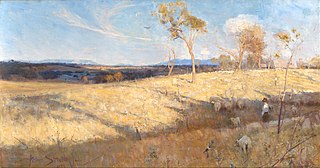
The Heidelberg School was an Australian art movement of the late 19th century. It has been described as Australian impressionism.
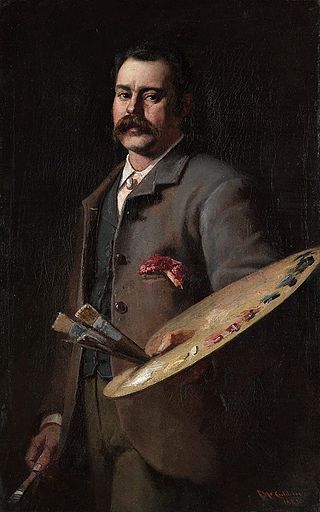
Frederick McCubbin was an Australian artist, art teacher and prominent member of the Heidelberg School art movement, also known as Australian impressionism.
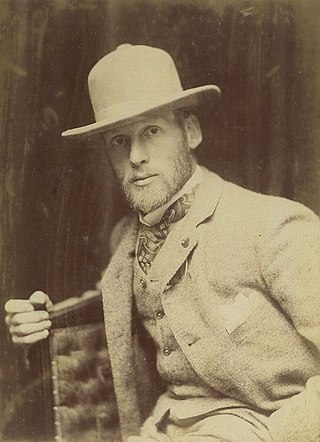
Thomas William Roberts was an English-born Australian artist and a key member of the Heidelberg School art movement, also known as Australian impressionism.

Charles Edward Conder was an English-born painter, lithographer and designer. He emigrated to Australia and was a key figure in the Heidelberg School, arguably the beginning of a distinctively Australian tradition in Western art.

Sir Arthur Ernest Streeton was an Australian landscape painter and a leading member of the Heidelberg School, also known as Australian Impressionism.

The Box Hill artists' camp was a site in Box Hill, Victoria, Australia favoured by a group of plein air painters in the mid to late 1880s who later became associated with the Heidelberg School art movement, named after Heidelberg, the site of another one of their camps.
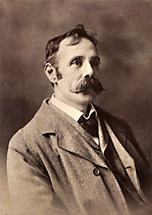
Walter Herbert Withers was an English-born Australian landscape artist and a member of the Heidelberg School of Australian impressionists.
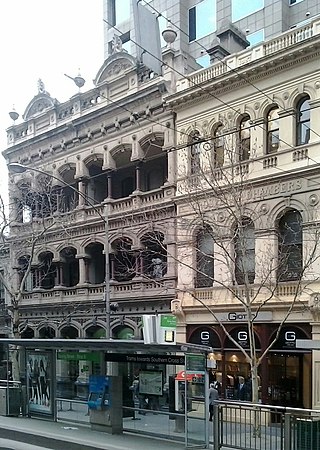
Grosvenor Chambers, at number 9 Collins Street, Melbourne, contained the first custom-built complex of artists' studios in Australia.

The 9 by 5 Impression Exhibition was an art exhibition held in Melbourne, Victoria, Australia. It opened on 17 August 1889 at Buxton's Rooms on Swanston Street and featured 183 "impressions", the majority of which were painted by Charles Conder, Tom Roberts and Arthur Streeton, three leading members of the Heidelberg School art movement, also known as Australian impressionism. Two other members, Frederick McCubbin and Charles Douglas Richardson, made smaller contributions.

David Davies was an Australian artist who was associated with the Heidelberg School, the first significant Western art movement in Australia.

A holiday at Mentone is an 1888 painting by Charles Conder, a leading member of the Heidelberg School movement, also known as Australian impressionism. It depicts people engaged in seaside activities on a sunny day at Mentone Beach, in the Melbourne suburb of Mentone.

Golden Summer, Eaglemont is an 1889 landscape painting by Australian artist Arthur Streeton. Painted en plein air at the height of a summer drought, it is an idyllic depiction of sunlit, undulating plains that stretch from Streeton's Eaglemont "artists' camp" to the distant blue Dandenong Ranges, outside Melbourne. Naturalistic yet poetic, and a conscious effort by the 21-year-old Streeton to create his grandest work yet, it is a prime example of the artist's distinctive, high-keyed blue and gold palette, what he considered "nature's scheme of colour in Australia".

Mentone Beach is a beach located in Mentone, on Port Phillip Bay, Victoria, Australia, 21 kilometres south from the Melbourne City Centre. Mentone beach is the northern section of a beach that extends alongside Beaumaris Bay from the cliffs at Rickett's Point in Beaumaris to Frankston in the south on the eastern shoreline of Port Phillip Bay.

Leon Pole was an Australian artist who was associated with the Heidelberg School art movement, also known as Australian Impressionism.

Louis Abrahams was a British-born Australian tobacconist, art patron, painter and etcher associated with the Heidelberg School art movement, also known as Australian Impressionism.

The Exhibition of Australian Art in London was a show organised by the trustees of the Art Gallery of New South Wales (AGNSW), notably Julian Ashton, and financially supported by the philanthropist Eadith Walker. Held at London's Grafton Galleries between April and September 1898, it featured 371 artworks made in Australia by 114 artists, and was the first major exhibition of Australian art to occur internationally.

John Llewellyn Jones, often referred to as Llewellyn or J. Llewellyn Jones, was an Australian artist and photographer who was associated with the Heidelberg School art movement, also known as Australian impressionism.

Thomas Humphrey was a Scottish-born Australian artist and photographer who was associated with the Heidelberg School art movement, also known as Australian impressionism.
Sedon Galleries was a commercial art gallery in Melbourne, Australia, representing Australian traditional, impressionist and post-impressionist painting and prints. It operated from 1925 to 1959.
References
- ↑ Ed. Scott Murray, Australia on the Small Screen 1970-1995, Oxford Uni Press, 1996 p219
- Contemporary review from Sydney Morning Herald accessed 5 August 2013 - ↑ Walsh, Geraldine (22 July 1985). "The Heidelberg School has a spell at Brideshead", The Sydney Morning Herald .
- ↑ Heidelberg School Archived 8 May 2017 at the Wayback Machine , Australia.gov.au. Retrieved 17 March 2016.
